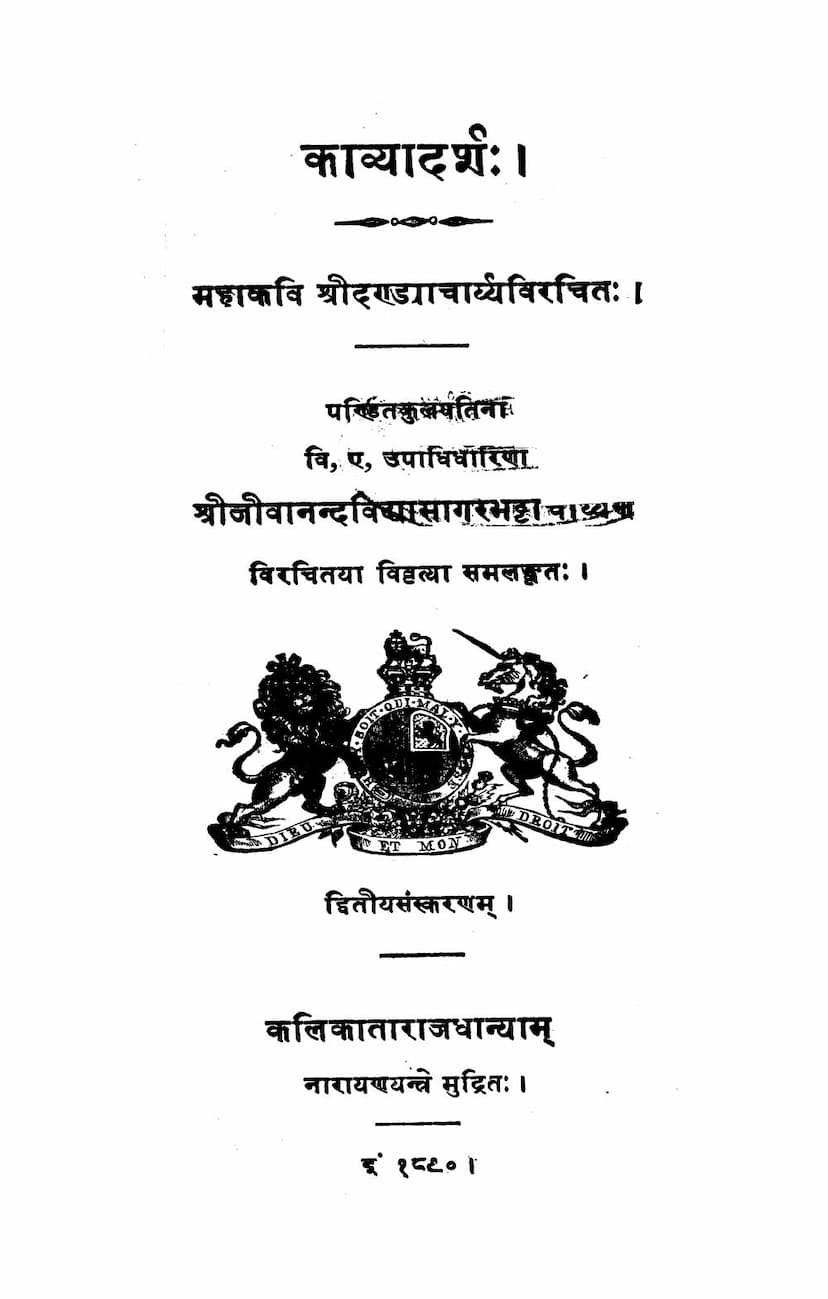Kavyadarsh
Added to library: September 2, 2025

Summary
The provided text is a Jain commentary by Jivanand Vidyasagar Bhattacharya on the Kavyadarsha by the Mahakavi Dandin. The commentary, titled Kavyadarsha Vyakhyana, is the second edition and was published in Calcutta in 1880.
The text outlines the structure and content of the Kavyadarsha, focusing on literary theory and aesthetics. It's divided into several chapters, as indicated by the table of contents.
Here's a summary of the key sections covered in the provided pages:
Book Title: Kavyadarsha Author of Original Work: Mahakavi Shri Dandinacharya Author of Commentary: Shri Jivanand Vidyasagar Bhattacharya, B.A. Publisher: Kalikata Rajdhnyam (Calcutta) Year: 1880 (Second Edition)
Overall Purpose: The commentary provides an in-depth explanation and analysis of Dandin's Kavyadarsha, a foundational text in Indian poetics.
Key Themes and Sections Covered:
-
Chapter 1 (Page 1-55): This chapter focuses on the general principles of poetry (Kavya).
- Introduction and Mangalacharan (Invocation): Begins with prayers and salutations.
- Praise of Vak (Speech) and Kavya (Poetry): Discusses the importance and essence of speech and poetry.
- Definition of Kavya: Explains what constitutes poetry.
- Classification of Kavya: Divides poetry into different types.
- Qualities of Kavya (Guna): Elaborates on the aesthetic qualities that enhance poetry, such as Prasada (clarity), Samata (evenness), Madhurya (sweetness), Sukumarata (delicacy), Arthavyakti (expressiveness), Audarya (grandeur), Ojas (vigor), Kanti (lustre), and Samadhi (concentration).
- Causes of Kavya: Discusses the elements that contribute to the creation of poetry.
- Figures of Speech (Alankara) - General Principles: Introduces the concept of figures of speech as adornments of poetry.
- Specific Figures of Speech (Upama, Rupaka, etc.): Details various figures of speech, including Simile (Upama) and Metaphor (Rupaka), and their numerous sub-classifications.
-
Chapter 2 (Page 56-194): This chapter delves into a more detailed analysis of various Figures of Speech (Alankaras).
- Detailed Classification of Upama (Simile): Explains numerous types of similes like Dharmopama, Vastupama, Viparyasopama, Malopama, Utprekshitopama, etc.
- Detailed Classification of Rupaka (Metaphor): Discusses various forms of metaphors, including Samastarupaka, Vyastarupaka, Samastavyastarupaka, etc.
- Other Figures of Speech: Covers a wide array of figures of speech such as Vyathireka (Contrast), Samasokti (Condensed Meaning), Atishayokti (Exaggeration), and Utpreksha (Hyperbole), and their sub-categories.
- Riti (Style): Explains different poetic styles like Vaidarbhi and Gaudi.
- Anupras (Alliteration): Discusses the concept and types of alliteration.
- Yamaka (Rhyme): Introduces rhyme and its importance.
- Dosas (Defects) in Kavya: Identifies flaws that can detract from poetry.
-
Chapter 3 (Page 185-274): This chapter continues the discussion on figures of speech and introduces other important literary concepts.
- More Figures of Speech: Continues the detailed explanation of figures of speech, including Nidarsana (Illustration), Sahokti (Conjunction), Parivritta (Transposition), Vyanjokti (Irony), Bhavikamy (Poetic Fancy), etc.
- Arthantaranyasa (Figurative Passage): Explains the use of supporting arguments or general statements to illustrate specific points.
- Vyatireka (Contrast): Further elaborates on contrasting figures of speech.
- Vibhavana (Uncaused Cause): Discusses instances where an effect is attributed to an unusual or seemingly non-existent cause.
- Samasokti (Condensed Meaning): Details how brief phrases can convey profound meaning.
- Atishayokti (Exaggeration): Explores hyperbole and its various forms.
- Utpreksha (Figurative Conception): Explains the use of imaginative comparisons.
- Yamaka (Rhyme): Continues the discussion on rhyme, including its complex forms like Gomutrika and Sarvatobhadra.
- Prahelika (Riddles/Enigmas): Discusses riddles and their literary function.
- Dosas (Defects): Provides a more comprehensive list of poetic defects.
Commentary's Approach: The commentary by Jivanand Vidyasagar Bhattacharya aims to elucidate Dandin's original text. It seems to follow a traditional approach of explaining the Sanskrit verses, defining terms, providing examples, and sometimes referencing other authoritative texts in Indian poetics (like Sahitya Darpana, Prakasha, etc.). The commentary also addresses differing opinions and interpretations, providing a scholarly analysis.
The text emphasizes the importance of poetic qualities, figures of speech, and the avoidance of defects for creating effective and aesthetically pleasing poetry. It reflects the rich tradition of Sanskrit literary criticism and the detailed study of Alankara Shastra (the science of poetics).